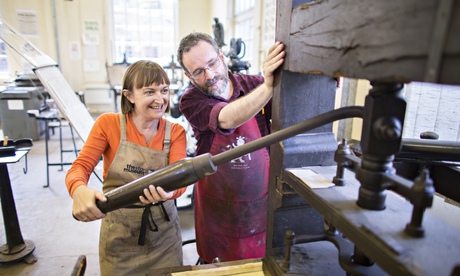
I’ve just counted them: four different ways to read a book or newspaper article digitally in my house. I appreciate all these glowing screens, yet I hanker for the printed word, for the smell of a book and the sound of turning pages.
I don’t want to give up on the printed page just yet, so I decide to sign up to a printing workshop using the antique presses at the Bodleian Library in Oxford. Entering the printing room gives the impression of stepping back in time: workbenches are splattered with ink, the walls lined with shelves stuffed with boxes of type and sheaves of paper. The presses themselves, imposing structures of wood and iron, dominate the room.
Paul Nash, superintendent of the presses, begins by introducing us to the sometimes gory history of printing. “Of course, human skin was used to make vellum too,” he says. “But it doesn’t work as well as sheep skin.”
The story of print is crammed with interesting trivia like this. I learn that Mendelssohn’s Hark, The Herald Angels Sing was originally composed in praise of Johannes Gutenberg, the inventor of moveable type. The Gutenberg Bible, printed in the mid-1400s, took about two years to produce – a miracle of speed back then.
Printing remained sporadic at first: the first book to come off the presses in Oxford was Tyrannius Rufinus’s Expositio in Symbolum Apostolorum in 1478, mere decades after Gutenberg’s breakthrough.
We, meanwhile, are to hand-set a short piece of text and print it as a page in a pamphlet using techniques and machinery that haven’t changed since the early 19th century.
First we practise setting and spacing type, a fiddly undertaking that would come naturally to any Lego aficionado. Once the type is set and placed on a wooden “forme” to fit the relevant press, it’s time to start printing.
We try two different presses, learning how techniques evolved over the years. The 18th-century “common press” has an imposing wooden frame, rather like an old-fashioned laundry mangle. Using inking balls shaped like enormous mushrooms made of wood and leather, we daub ink evenly over the type.
I’m grateful that the Bodleian’s attention to detail and dedication to authenticity doesn’t stretch to the ancient practice of soaking the hide covers of the inking balls in a bath of urine each night.
Having inked the type to Paul’s satisfaction, I lay a piece of paper on to the hinged frame and lower it carefully on to the forme. Then comes the fun bit: turning a variety of wooden handles as tall as me until the paper moves into the jaws of the apparatus and is flattened on to our type by a weight. It’s a remarkably physical process, requiring both hands, and the smell of the ink permeates the air.
To unveil our final product, we reverse the handles and then lift the paper. It parts from the inked type with a visceral squelch, like a welly released from mud, and I turn it over to admire our handiwork.
It has taken me two hours to print what would take two minutes to produce using a computer. On a small piece of thickish card (not human-skin vellum) we’ve imprinted a cheerily ironic picture of Death arriving at a printing press and a single line of type. The sense of achievement from all that effort and precision is so much more satisfying than simply pressing send.
The Bodleian hand-printing workshops and short courses for adults and children run regularly at the Story Museum in Oxford

